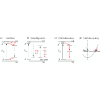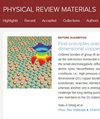Uncovering the presence or absence of photoluminescence from iron ions in crystals
IF 3.4
3区 材料科学
Q2 MATERIALS SCIENCE, MULTIDISCIPLINARY
引用次数: 0
Abstract
The poor understanding of the optical transitions and luminescent mechanisms critically hindered the development of near-infrared (NIR) -activated phosphors, and efficient luminescence from Fe(Oh) has rarely been reported. In our study, we delve into these challenges and realize their correlation with the quenching mechanism of luminescence. First-principles calculations are utilized to analyze energy levels and electron-phonon coupling parameters, further elucidating potential deactivation pathways and factors influencing the occurrence of photoluminescence. A heuristic rule based on ligand-field strength, determined by the absorption wavelength of occupying the same octahedral site in oxides, is proposed to facilitate the prediction of both the potential and wavelength of emission. Our study offers consistent and reliable interpretations for the difficulties and challenges of iron-doped crystals, and provides valuable insights on the design and optimization of -based phosphors.

揭示晶体中是否存在铁离子发出的光致发光
对光学跃迁和发光机制的不甚了解严重阻碍了近红外(NIR)Fe3+ 激活荧光粉的发展,而 Fe(Oh)的高效发光也鲜有报道。在我们的研究中,我们深入探讨了这些难题,并认识到它们与 Fe3+ 发光的淬灭机制之间的关联。我们利用第一原理计算分析了能级和电子-声子耦合参数,进一步阐明了潜在的失活途径和影响光致发光发生的因素。我们提出了一个基于配体场强的启发式规则,该规则由占据氧化物中相同八面体位点的 Cr3+ 的吸收波长决定,有助于预测 Fe3+ 的发射电位和波长。我们的研究为掺铁晶体的困难和挑战提供了一致而可靠的解释,并为设计和优化基于 Fe3+ 的荧光粉提供了宝贵的见解。
本文章由计算机程序翻译,如有差异,请以英文原文为准。
求助全文
约1分钟内获得全文
求助全文
来源期刊

Physical Review Materials
Physics and Astronomy-Physics and Astronomy (miscellaneous)
CiteScore
5.80
自引率
5.90%
发文量
611
期刊介绍:
Physical Review Materials is a new broad-scope international journal for the multidisciplinary community engaged in research on materials. It is intended to fill a gap in the family of existing Physical Review journals that publish materials research. This field has grown rapidly in recent years and is increasingly being carried out in a way that transcends conventional subject boundaries. The journal was created to provide a common publication and reference source to the expanding community of physicists, materials scientists, chemists, engineers, and researchers in related disciplines that carry out high-quality original research in materials. It will share the same commitment to the high quality expected of all APS publications.
 求助内容:
求助内容: 应助结果提醒方式:
应助结果提醒方式:


